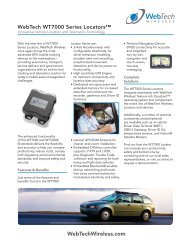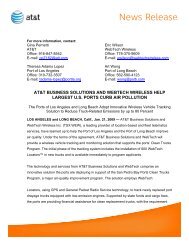2010 ANNUAL REPORT - Webtech Wireless
2010 ANNUAL REPORT - Webtech Wireless
2010 ANNUAL REPORT - Webtech Wireless
You also want an ePaper? Increase the reach of your titles
YUMPU automatically turns print PDFs into web optimized ePapers that Google loves.
NOTES TO THE CONSOLIDATED FINANCIAL STATEMENTSFor the twelve months ended December 31, <strong>2010</strong> and December 31, 2009and the five-month period ended December 31, 2008GoodwillGoodwill represents the excess of the purchase price of acquiredbusinesses over the estimated fair value of net identifiable assetsacquired. Goodwill is not subject to amortization but is tested forimpairment on an annual basis, or more frequently, if events orcircumstances indicate that it might be impaired. If the carryingamount exceeds the fair value of the goodwill, an impairment lossis recognized equal to that excess through a charge to the consolidatedstatement of operations.Impairment of long-lived assetsLong-lived assets are assessed for future recoverability whenevents or circumstances indicate that they might be impaired.When the net carrying amount of a capital asset exceeds its estimatednet recoverable amount determined using undiscountedcash flows, the asset is written down to its fair value with a chargeto the consolidated statement of operations.Warranty provisionGenerally, a one-year warranty on hardware sales is providedby the Company. A warranty provision equal to 1% of 12-monthtrailing hardware sales is provided in the financial statements.The Company periodically reviews the adequacy of this warrantyprovision.LeasesLeases entered into are classified as either capital or operatingleases. Leases that transfer substantially all of the benefits andrisks of ownership of property to the Company are accountedfor as capital leases. Assets acquired under capital leases arerecorded as an asset on the balance sheet with a correspondingincrease to the capital lease obligation and amortized over thelife of the lease.Leases in which a significant portion of the risk and rewards ofownership are retained by the lessor are classified as operatingleases. Payments made under operating leases are charged tooperations on a straight-line basis over the term of the lease. Thebenefits of lease inducements provided to the Company are recognizedon a straight-line basis over the term of the lease agreement.Income taxesThe Company accounts for income taxes using the asset andliability method. Under this method, current income taxes are recognizedfor the estimated income taxes payable for the currentyear. Future income taxes and liabilities are recognized for temporarydifferences between the tax and accounting basis of assetsand liabilities as well as for the benefit of losses available to becarried forward to future years for tax purposes. Future incometax assets and liabilities are measured using substantively enactedtax rates expected to apply to taxable income in the year in whichthose temporary differences are expected to be recovered orsettled. The effect on future income tax assets and liabilities of achange in tax rates is recognized in operations in the period thatsuch rates are substantively enacted. Any future income tax assetis reduced by a valuation allowance to the extent that it is morelikely than not that some portion or all of the asset will not berealized.Revenue recognitionThe Company derives revenue from the sale of telematics hardwareand software, as well as professional services associated with customizingits product. License, maintenance and subscription revenueis derived from location-based software and software services.Revenue from hardware and software license sales is recognizedwhen persuasive evidence of an arrangement exists, the fee isfixed or determinable, the hardware is shipped or the softwareis delivered and when management has determined that therevenue is collectible. Revenue from professional services isrecognized as earned, based on performance according to specificterms of the contract or on the basis of the percentage ofcompletion method where the revenue is reconcilable to workcompleted as a proportion of total work to be completed, whenthe fee is fixed and determinable, and management has determinedthat the revenue is collectible. All foreseeable losses areincluded in earnings when it is determined that such foreseeablelosses are estimated to be likely to occur. Revenue from subscriptionservices is invoiced in advance and deferred and recognizedon a monthly basis as the services are provided.Revenue arrangements with multiple elements are reviewed inorder to determine whether the multiple elements can be dividedinto separate units of accounting. If separable, the considerationreceived is allocated among the separate units of accountingbased on their respective fair values, and the applicable revenuerecognition criteria are applied to each of the separate units.Otherwise, the applicable revenue recognition criteria are appliedto the revenue arrangement as a single unit.Research and developmentResearch expenditures are expensed when incurred.Development costs are capitalized in the event they meet capitalizationcriteria under Canadian GAAP, otherwise they areexpensed as incurred. To date, no development costs have beencapitalized.Government assistanceScientific research tax credits are accrued at the time the relatedcosts are incurred provided that their recovery is reasonablyassured. Scientific research tax credits arising from capital expendituresare applied to the cost of the assets and refundable creditsarising from other expenditures are applied as a reduction ofsuch expenses.Stock-based compensationThe fair value of employee share purchase option grants is calculatedat the grant date and amortized over the vesting period ofthe grant with a corresponding increase to contributed surplus.The fair value of stock-based payments to non-employees is remeasuredat each balance sheet date until the earlier of the com-37




